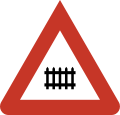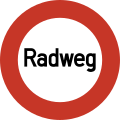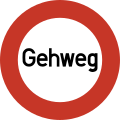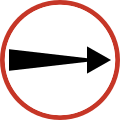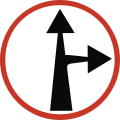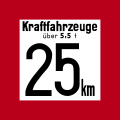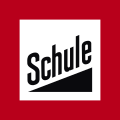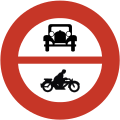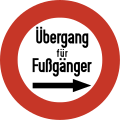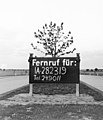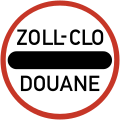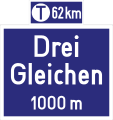Illustration of the traffic signs in the German Reich from 1938 to 1945
The picture table of the traffic signs in the German Reich from 1938 to 1945 shows the traffic signs in the German Reich as they were resolved by the new version of the Road Traffic Act (StVO) in the version of November 13, 1937. This StVO came into force on January 1, 1938. In addition to the traffic signs of the StVO, the traffic-related sign arrangements in the railway building and operating regulations (abbreviated designation: operating regulations, BO) are discussed here. On the basis of the decree on traffic signs and facilities on Reichsautobahn of April 15, 1938, the Autobahn traffic signs are also dealt with here.
The 1937 StVO was a completely new version, which, with many additions and changes, remained in force until the 1970s. In the Federal Republic of Germany it was replaced by a new regulation on March 1, 1971, in the German Democratic Republic on January 1, 1957. For the first time in 1937, the road traffic regulations also included a road traffic licensing regulation (StVZO).
On May 28, 1934, a new Reich Road Traffic Ordinance was enacted and decreed. The much more comprehensive revision of 1937 was due, on the one hand, to the rapid advances in road traffic technology and the growth in traffic, and on the other hand, the shifts in competencies and structural changes within the now established National Socialist state became clear. While the Transport Minister Paul von Eltz-Rübenach , who had taken over from the Weimar Republic , was responsible for the 1934 Road Traffic Act , in 1937 the Minister of the Interior Wilhelm Frick , the Reichsführer SS and head of the German Police in the Ministry of the Interior, Heinrich Himmler and Fritz Todt as inspector general took the place of the Transport Minister German road system as the publisher of the traffic regulations.
It was emphasized again that commercial advertising in connection with traffic signs was not permitted. This type of advertising was part of everyday street life in the German Empire and especially during the Weimar Republic . As the signs realized in 1937 show, the StVO was based very closely on the international guidelines for traffic signs and scrapped many older German signs that took a special route.
Colours
In 1937 the traffic signs were based on the RAL 840 B 2 color card for vehicle paints , which had been introduced in June 1932. This color card was replaced in 1940 during the Second World War by the color register 840 R, which also dealt in particular with the colors for military equipment. This register remained valid until 1971 and was replaced with the new version of the StVO by new RAL systems.
The following colors were specified in color register 840 B 2 for traffic signs. The current RAL numbers, which already existed in register 840 R, follow after the dash:
- RAL 6 (red) - RAL 2002 (blood orange)
- RAL 24 (yellow) - RAL 2007 (luminous light orange)
- RAL 32 h (blue) - RAL 5002 (ultramarine blue)
Although no standard has been set for black and white, it is pointed out that the standard color for white is RAL 1 (RAL 9002 - gray-white) and for black RAL 5 (RAL 9005 - jet black). A white paint was also specified for the posts of the traffic signs; this should be yellow for place-name signs and signposts.
Since a large number of the characters from that time appeared in enamelled versions, there could be considerable color deviations, since enamel was only defined according to RAL from 1940. The manufacturing companies therefore often chose approximate values. During the second phase of the war, in particular, colors had to be stretched many times, as color pigments, for example, were no longer available. Often, cheap white pigments were used as an additive, which could change the prescribed color values considerably.
typography
The typographical basis was the standard sheet DIN Vornorm 1451 . As a recommendation, it was determined that the fonts contained there should have a minimum line thickness of seven millimeters. The numbers appearing on the traffic signs should be the height of the capital letters. Big letters had to be not less than 50 millimeters and small letters not less than 35 millimeters high. Exceptions to these regulations have been set out on separate sample sheets.
Despite clearly defined DIN fonts, the numerous deviations and variants to the legally prescribed writing system are clearly noticeable. The typographic characters, which at that time were often created by sign painters or in enamelling factories, therefore have an almost inexhaustible range of variants in the typeface and the expression of individual letters in the specified font styles - narrow, medium and wide script. Even the representation of digits on the traffic signs reproduced in the Reichsgesetzblatt deviates significantly from DIN 1451.
Manufacturing
The signs to be set up had to be lightfast and weatherproof. In the case of warning signs in particular, it was desirable to make them reflective, luminous or illuminated. The Road Traffic Regulations explicitly point out that "small deviations from the dimensions that do not cause any noticeable changes to the sign are permitted for all traffic signs for special reasons". The beacons at level crossings had appropriately colored reflectors in the areas painted red.
I. Warning signs
(Pictures 1 to 10)
II. Mandatory and prohibitive signs
(Pictures 11 to 31)
III. Notice signs
(Pictures 32 to 52)
Signs for lanterns that don't burn all night
(Pictures 35 to 36)
Place-name sign
(Pictures 37 to 38)
Instead of the administrative district, since the introduction of the StVO, which came into effect on January 1, 1938, the term “ customs border district ” could be used in the border areas . There was no separate picture for this in the regulation.
Signpost for imperial roads
(Pictures 39 to 41)
Signpost for other paved roads
Signpost for unpaved roads
Reichsstrasse license plate
Signs for ring roads or collecting roads for long-distance traffic
Pre-signpost
(Pictures 46 to 51)
Signs for major roads
IV. Sign for directing traffic in the event of road closures
(Pictures 53 to 58)
Signal discs on bogies for traffic control in case of half-sided closures
(Pictures 53 to 54)
Signpost for diversions
(Pictures 55 to 56)
Sign for diversion of traffic on Reichsstraßen
(Pictures 57 to 58)
V. The most important of the older characters to be replaced by March 31, 1939 according to § 50
(Pictures 59 to 73)
Blocking signs for permanent blocking
(Pictures 59 to 64)
Blocking signs for closures on Sundays and public holidays
(Pictures 65 to 69)
Speed limit sign
(70 to 72)
Speed limit sign in front of schools
Unnumbered characters, but also valid from January 1, 1938
Additional boards
The illustrations of the white, rectangular additional boards with black inscriptions differed in the typographical details in the various printed works of that time. This also reflected the reality on the street. In addition, the Reich Law Gazette only specifies size information for the additional tables in Figures 22 and 23. The Reichsgesetzblatt did not provide a picture of the additional panels, which were not numbered at the time, but only a brief description with an indication of the size of some panels. Time restrictions were made clear by white inscriptions on the edge of the mandatory and prohibitive signs.
Stop signs for postal services
The Reichspost signs with the republican imperial eagle underlaid were produced until 1933 and often remained at their locations after the introduction of newer signs, mostly the walls of public buildings on the rural main roads. After 1933, however, new signs were also produced, now in the new (old) colors of the empire, black-white-red. Both signs became obsolete with the stop signs announced on July 28, 1939 .
Stop sign for Kraftpostlinien
(older sign)Stop sign for Kraftpostlinien
(new sign)
Marks for crossings at rail height
These signs for crossings at rail height were not in the road traffic regulations, but from 1934 in the sixth regulation amending the railway construction and operating regulations of November 20, 1934. This regulation appeared in the Reichsgesetzblatt , year 1934, part II, p. 1051– 1054 and was valid from December 10, 1934.
Warning crosses
Warning lights
A slowly flashing white light (45 flashes per minute) meant: The crossing is free for road traffic . A rapidly flashing red light (90 flashes per minute) meant: Stop! The crossing is closed to road traffic . Several models of warning lights were used to secure the unrestricted level crossings. The technically most demanding version was intended for multi-track, unbarred level crossings. When two trains approached the crossing from both directions, next to the obligatory red warning light, the words "Two trains" came on and an alarm clock went off. Paragraphs 79 (1) and 82 of the Railway Building and Operating Regulations govern the use of the signal system. Both the arms of the warning cross and the white-red border of the carrier plate were provided with round reflectors to make the signs even more recognizable for drivers in the dark. The warning lights were operated electrically or, if there was no power supply, with acetylene .
Early warning lights that did not become part of the railway building and operating regulations:
Subsequent pictures and additional innovations until 1945
1938
April
On April 15, 1938, the General Inspector for German Roads, Fritz Todt , issued a decree on traffic signs and facilities on Reichsautobahn . This decree continued to apply as federal law in accordance with Section 3 of the First General Administrative Regulation for the Order Management of Federal Highways of July 3, 1951 (Federal Gazette No. 132) in West Germany.
June
On June 5, the motorway travel call was introduced, for which a black board to be written on with chalk was set up in the median of the motorways. With the beginning of the war, on September 1, 1939, this service was discontinued by the Post and Reichsbahn.
Another decree of June 16 related to the uniform labeling of the town signs, which was supposed to clarify previously unclear details.
November
On November 1st, another change in the road traffic regulations came into force, which included two new images (Fig.30a, 30b).
Fig. 30b
Sketch for the marking of a road on which the right of way must be observed. With the parallel red lane markings along a side street, the driver should be brought to brake when entering a main street. The 200 millimeter wide horizontal stripe then formed the stop line and at the same time enabled a safer transition for pedestrians.
1939
July
On July 28, 1939, uniform stop signs for trams and motor vehicle lines were announced and published in the Reichsverkehrsblatt. These signs were considered traffic facilities in the sense of § 3 of the Road Traffic Regulations. The designation of the motor vehicle line should appear in green in the extended arm of the round symbol. This regulation remained in force in a revised form until September 20, 2006.
August
On August 12, 1939, the technical regulation RAB T-1 Iwkb 286 (RAB = Reichsautobahn) was issued, which contained specifications for three new motorway signs that dealt with the advance notice of motorway filling stations .
September
After the occupation of the so-called remaining Czech Republic , the German authorities set about implementing the traffic law applicable in Germany in the area that had now been declared the Protectorate of Bohemia and Moravia . For this purpose, some traffic signs had to be linguistically adapted. On September 27, 1939, corresponding signs were presented in the appendix with the regulation No. 242/1939 anchored in Czechoslovak law.
The following are examples that differed from the usual characters in the German Reich:
1942
In the fourth revised edition of the preliminary guidelines for the expansion of rural roads (RAL 1937) from December 1942, a revised shape of the guiding stones was prescribed. Under the designation "curbstones" these had already been included in the Reich Road Traffic Regulations from 1934 to 1938 with image e 3, but were dropped again with the new version from 1938. These older stones were painted white and had a head painted black. Guiding stones should enable safe and easy use of the roads in any weather and any time of day. They were to be set up in such a way that they could see road users, especially drivers, well and in good time.
Overall, the following were considered as control systems:
- 1. Guide stones and guide pegs,
- 2. Tree mirror,
- 3. Protection systems,
- 4. Hyphens.
1943
February
From 1943, the warning light systems with two lights - white and red - and systems that were additionally provided with the illuminated sign "Two trains" became part of the railroad with the Eleventh Ordinance on Changes to the Railway Construction and Operating Regulations of February 4, 1943 Building and operating regulations of July 17, 1928. This regulation became legally effective on February 23, 1943. In addition to the initial inclusion of the warning light systems, the lightning arrow for warning crosses was also included in the operating regulations.
May
In the amendment of May 19, 1943 to "Annex 1, traffic signs and traffic facilities", a new image (Fig. 34a) was introduced, which was intended to refer to the NSKK traffic assistance service. It was to be set up on the right-hand side of the lane in close proximity to the building in which the call station was located. The new symbols had to be procured and maintained by the National Socialist Motor Corps themselves. The white border was to be designed to be reflective.
Further additional signage
Since the early 1940s, small yellow flags were put up due to the weather, which carried the inscription "black ice".
Locally arranged traffic signs
Motorway signage
The following signs were not included in the new version of the road traffic regulations and remained largely unchanged until the 1956 StVO amendment. The same RAL color specifications were adhered to for the motorway signs as were used in the Reich Road Traffic Regulations. Usually the large blue highway panels were made of wood and plywood. They had a white border that could either be painted on or executed as a wooden frame. The white letters were painted on or, in some cases, were also made plastic. Early signs on the Reichsautobahn deviated even more from the DIN-standardized writing system than later versions. Overall, the hand-made character of the characters remained visible through local individual characteristics and through the respective skills of the local sign painter.
From 1937 onwards, the concrete roadways, which had been light up until then, had been colored black so as not to provide orientation for enemy aircraft in the event of war.
In 1938, so-called game crossing signs were initially set up on a trial basis at risk spots with wild animals. These showed a stag, roe deer or wild boar as symbols. It was hoped that these signs could possibly be removed "when the game got used to the changed conditions and found new feeding places." Serious accidents showed early on how important it was to heed these signs.
Signpost to the Reichsautobahn
Boards in the median
Among other things, there were signs in the median for crossed valleys, rivers and lakes.
Boards on the right edge of the road
Motorway advance notice: Wild boar crossing at 1200 meters;
Introduced in 1938Motorway advance notice: deer crossing at 2000 meters;
Introduced in 1938
literature
- Hans Lorenz: The Reichsautobahn in the forest. Forest biological, technical and legal basics for planning, construction and maintenance (= series of publications by Die Strasse 11), Volk und Reich, Berlin 1938.
- RAB T 1 Iwkb 193 of April 15, 1938: Provisional instructions for the implementation of the construction work on the Reichsautobahn No. 10, regarding traffic signs and traffic facilities on the Reichsautobahn. (Including signs for parking spaces, crossed rivers, deer crossing and slopes)
- RAB OBR Berlin: The signposting on the Berlin Ring of the RAB . In: Die Strasse 6 (1939), p. 322
- RAB T 2 Iwkb 57 of August 10, 1939: Provisional instructions for the marking of work and danger areas on the Reichsautobahn .
- RAB Iwk 433, 1941: Redesign of the Reichsautobahn signs
- Driver: The universal stand from Sm Kirchheim-Teck . In: Der RAB-Straßenmeister 3 (1941), p. 12.
- RAB Iwkbm 38, 1943: Renewal of the white dividing line on the Reichsautobahn
- Dietmar Fack: Automobiles, traffic and education. Motorization and socialization between acceleration and adaptation 1885–1945. Leske + Budrich, Opladen 2000, ISBN 3810023868 .
Web links
Remarks
- ^ Reichsgesetzblatt , part 1, year 1937, no. 56, date of issue: Berlin, November 16, 1937, p. 1190.
- ↑ Federal Law Gazette Part I, No. 108, published in Bonn, December 5, 1970, p. 1565.
- ↑ Law Gazette of the German Democratic Republic , Part I, No. 103, date of issue: Berlin, November 20, 1956, p. 1239.
- ↑ Walther Killy , Rudolf Vierhaus (ed.): German biographical encyclopedia (DBE) . Volume 4, Saur, Munich 1999, ISBN 3-598-23186-5 , p. 259.
- ^ Reichsgesetzblatt , year 1934, No. 59, date of issue: Berlin, May 30, 1934, p. 455 ff.
- ^ Reichsgesetzblatt , year 1937, No. 56, date of issue: Berlin, November 16, 1937, p. 1181.
- ↑ a b c d Reichsgesetzblatt , year 1937, No. 56, date of issue: Berlin, November 16, 1937, p. 1195.
- ↑ a b Johannes Denecke: Lackfarben 1932–1945. In: Johannes Denecke Camouflage paints of the German army 1914 to today , Bernard & Graefe, Bonn 1999, ISBN 3-7637-5990-5 . Pp. 104-106.
- ^ Road Traffic Technology 4, 1973 (17th year), pp. 138-139; here: p. 131.
- ^ Johann Peter Noth, Reimund Wieg: 20 years of quality mark traffic signs . In: Straßenverkehrstechnik 4, 1978 (22nd year), pp. 138-139; here: p. 138.
- ↑ Commercial legal protection and copyright. Verlag Chemie, Weinheim an der Bergstrasse 1958, p. 444.
- ↑ a b c d e Reichsgesetzblatt , year 1937, No. 56, date of issue: Berlin, November 16, 1937, p. 1192.
- ↑ a b c d Reichsgesetzblatt , year 1937, No. 56, date of issue: Berlin, November 16, 1937, p. 1193.
- ^ Ordinance on behavior in road traffic (Road Traffic Regulations - StVO -) of November 13, 1937 . In: Reichsgesetzblatt , Part 1, year 1937, No. 56, Berlin, November 16, 1937, p. 1193.
- ↑ a b c d Reichsgesetzblatt , year 1937, No. 56, date of issue: Berlin, November 16, 1937, p. 1191.
- ↑ K. Pfanstiel (Ed.): "Textbook for drivers of all classes." Degener Verleg, 1938. P. 61.
- ^ Kurt Albrecht: Automotive guidelines . 8th edition, Elbe Verlag, Dresden 1943. p. 291 and plate 115.
- ↑ K. Pfanstiel (Ed.): "Textbook for drivers of all classes." Degener Verleg, 1938. P. 61.
- ^ Order of the Reich Minister of Transport for the introduction of uniform stop signs for trams and motor vehicle lines . From July 19, 1939. In: Reichsverkehrsblatt B, No. 33, from July 29, 1939
- ↑ E. Besser: Lighting technology in railway operations . In: Rudolf Fewig (Ed.): Handbuch der Lichttechnik , Part 1, Springer, Berlin 1938, pp. 881–894; here: p. 893.
- ↑ E. Behr: Securing path crossings at rail height . In: VDI-Zeitschrift , 34 Volume 82, (1939), p. 965 ff .; here: p. 970.
- ↑ a b Beck's short comments: Johannes Floegel, Fritz Hartung: Road traffic law. Road traffic regulations, road traffic approval regulations. Road Traffic Act, provisions of the StGB, the StPO and the JGG for the protection of train path traffic with an appendix of additional regulations. 8th edition, Beck, Munich 1966. p. 114.
- ^ Road traffic regulations, Beck'sche text editions, 10th edition, Beck, Munich 2008, p. XVII
- ^ Volkhard Stern: Reichsautobahn and Reiseruf - An early telephone service for travelers in motor vehicles. In: The archive. Magazin zur Post- und Telekommunikationsgeschichte , 1, 2008, pp. 28–33; here p. 32.
- ^ Reichsgesetzblatt , year 1938, No. 168, date of issue: Berlin, October 17, 1938, p. 1434.
- ^ Order of the Reich Minister of Transport for the introduction of uniform stop signs for trams and motor vehicle lines . From July 19, 1939. In: Reichsverkehrsblatt B, No. 33, from July 29, 1939
- ^ First law on the adjustment of federal law in the area of responsibility of the Federal Ministry for Transport, Building and Urban Development. From September 19, 2006. Article 27: Repeal of the regulation on the introduction of uniform stop signs for trams and motor vehicle lines. In: Bundesgesetzblatt I, No. 44, Bonn on September 30, 2006, pp. 2146–2153; here: p. 2148 and p. 2153.
- ↑ Vládní nařízení ze dne September 27, 1939 o chování v silniční dopravě (dopravní řád silniční - d.ř.s.). Date of publication: October 30, 1939, No. 242/1939 Sb., Part: 89/1939.
- ^ Preliminary guidelines for the expansion of the country roads , Verlag Volk und Reich, 4th edition December 1942, p. 23.
- ↑ Eleventh ordinance amending the railway building and operating regulations of February 4, 1943. In: Reichsgesetzblatt , No. 5, Part II, February 16, 1943, pp. 17-29.
- ↑ Ordinance amending the Ordinance on Conduct in Road Traffic. In: Reichsgesetzblatt , year 1943, No. 55, date of issue: Berlin, May 31, 1943, p. 334.
- ^ Kurt Albrecht: Automotive guidelines . 8th edition, Elbe Verlag, Dresden 1943. p. 293.
- ^ Volkhard Stern: Reichsautobahn and Reiseruf - An early telephone service for travelers in motor vehicles. In: “The archive. Magazin zur Post- und Telekommunikationsgeschichte ”, 1, 2008, pp. 28–33; here: p. 28.
- ↑ A. Becker: About the use of electrically charged pasture fences for game protection on the Reichsautobahn . In: German technology. The technopolitical magazine 1941, p. 527.
- ^ Die Betonstraße , Volume 14, Issue 1–12 (1939), p. 140.
- ↑ The presented universal stand for traffic signs had a concrete base with an embedded tubular stand with a diameter of 75 mm and attached sign holders. The use of the stand made it possible to store the signs on shelves, which saves a lot of space.





